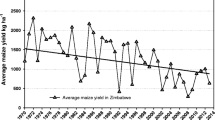Abstract
In eastern Zambia, nitrogen deficiency is a major limiting factor for increased food production. Soil fertility has been declining because of nearly continuous maize (Zea mays) cultivation with little or no nutrient inputs. The use of short-duration tree fallows was one of several agroforestry options hypothesized to restore soil fertility. Sesbania sesban, an indigenous N2-fixing tree was the most promising among species tested in screening trials. Several studies since 1987 have demonstrated the dramatic potential of two- or three-year sesbania fallows in restoring soil fertility and increasing maize yields. Analyses showed that these improved fallow systems were feasible, profitable, and acceptable to farmers. Results suggest that high maize yields following fallows are primarily due to improved N input and availability by the fallows. The potential to increase maize production without applying mineral fertilizers has excited thousands of farmers who are enthusiastically participating in the evaluation of this technology. The number of farmers who are testing a range of improved fallow practices has increased from 200 in 1994 to over 3000 in 1997. Presently, a strong network of institutions comprising government, NGOs, development projects, and farmer organizations is facilitating the adaptive research and expansion of improved fallow technology in eastern Zambia. Key elements in the research process that contributed to the achievements are effective diagnosis of farmers' problems, building on farmers' indigenous knowledge, generating several different fallow options for farmers to test, ex-ante economic analysis, farmer participation in on-farm trials, and development of a network for adaptive research and dissemination.
Similar content being viewed by others
References
Borlaug NE (1988) Challenges for global food and fiber production. Journal of the Royal Swedish Academy of Agriculture and Forestry Supplement 21: 15–55.
Bunch R (1995) Two Ears of Corn. A Guide to People-Centered Agricultural Improvement. Third Edition. World Neighbors, Oklahoma City, OK, USA, 251 pp
Celis R, Milimo J and Wanmali S (1991) Adopting Improved Farm Technology: A Study of Smallholder Farmers in Eastern Province, Zambia. International Food Policy Research Institute, Washington DC
Cheru F (1995) Structural adjustment, poverty alleviation and democratization: Conflicting objectives. In: Melin M (ed) Democracy in Africa On Whose Terms?, pp 41–59. Forum Syd, Falun, Sweden
De Rouw A (1995) The fallow period as a weed-break in shifting cultivation (tropical wet forests). Agriculture, Ecosystems and Environment 54: 31–43
Evans DO and Rotar PP (1987) Productivity of sesbania species. Tropical Agriculture (Trinidad) 64: 193–200
FAO (1993) Strategies for Sustainable Agriculture and Rural Development (SARD): The role of Agriculture, Forestry and Fisheries. FAO, Rome
Franzel S, Phiri D and Kwesiga FR (1999) Assessing the Adoption Potential of Improved Tree Fallows in Eastern Zambia. AFRENA Working Paper No. 124, ICRAF, Nairobi, Kenya
Giller KE and Wilson KJ (1991) Nitrogen Fixation in Tropical Cropping Systems. CAB International, Wallingford, UK
ICRAF (1994) ICRAF Annual Report for 1993. International Centre for Research in Agroforestry, Nairobi, Kenya
Juo AS and Lal R (1977) The effect of fallow and continuous cultivation on the chemical and physical properties of an Alfisol in Western Nigeria. Plant and Soil 47: 567–584
Kwesiga F (1990) The potential of Sesbania sesban in the traditional land use systems in Zambia. In: Macklin B and Evans DO (eds) Perennial Sesbania Species in Agroforestry Systems, pp 131–138. Nitrogen Fixing Tree Association, Waimanalo, Hawaii, USA
Kwesiga F and Chisumpa S (1992) Ethnobotanical Survey in Eastern Province, Zambia. AFRENA Report No. 49. ICRAF, Nairobi, Kenya
Kwesiga F and Coe R (1994) Potential of short rotation sesbania fallows in eastern Zambia. Forest Ecology and Management 64: 161–170
Kwesiga F and Kamau I (1989) Agroforestry Potential in the Unimodal Upland Plateau of Zambia. AFRENA Report No. 7. ICRAF, Nairobi, Kenya
Ngugi D (ed) (1988) Agroforestry Research Project for the Maize-Livestock System in the Unimodal Upland Plateau (Chipata and Katete) of Eastern Province of Zambia. AFRENA Report No. 10. ICRAF, Nairobi, Kenya
Pretty NJ (1995) Regenerating Agriculture. Policies and Practices for Sustainability and Self-Reliance. Earthscan Publications Limited, London, 320 pp
Rogers EM (1962) Diffusion of Innovations. The Free Press, New York
Sanchez PA and Palm CA (1996) Nutrient cycling and agroforestry in Africa. Unasylva 185(47): 24–28
Sprent JI (1987) The ecology of the Nitrogen Cycle. Cambridge University Press, Cambridge, UK
Tabor RS (1995) Agricultural Research in an Era of Adjustment Policies, Institutions and Progress. EDI Seminar Series. The World Bank, Washington DC
Author information
Authors and Affiliations
Corresponding author
Rights and permissions
About this article
Cite this article
Kwesiga, F.R., Franzel, S., Place, F. et al. Sesbania sesban improved fallows in eastern Zambia: Their inception, development and farmer enthusiasm. Agroforestry Systems 47, 49–66 (1999). https://doi.org/10.1023/A:1006256323647
Issue Date:
DOI: https://doi.org/10.1023/A:1006256323647




